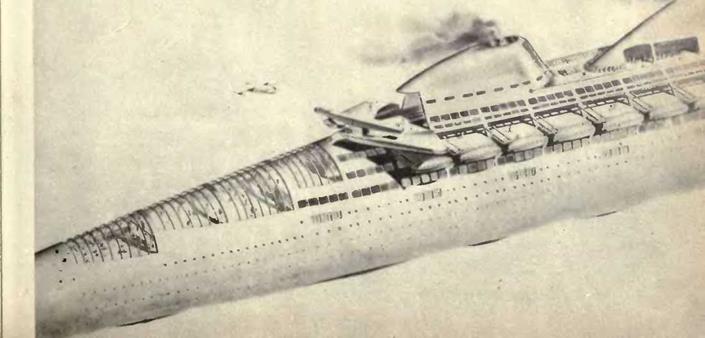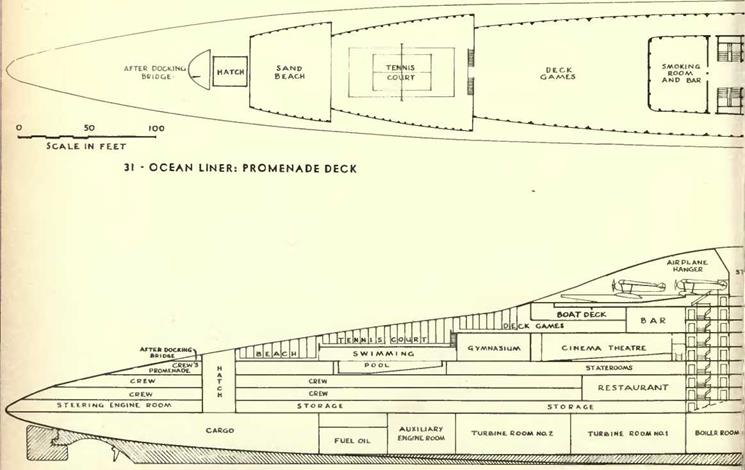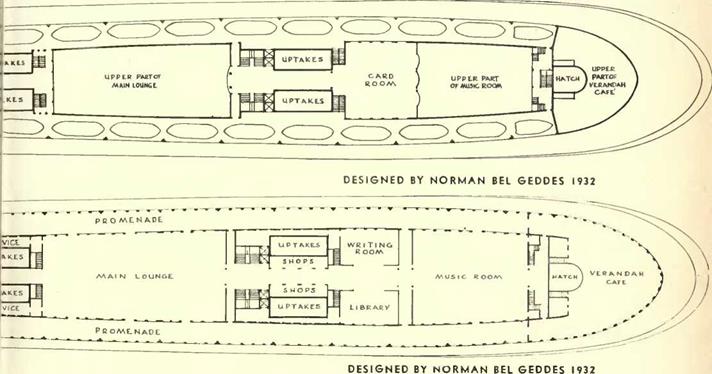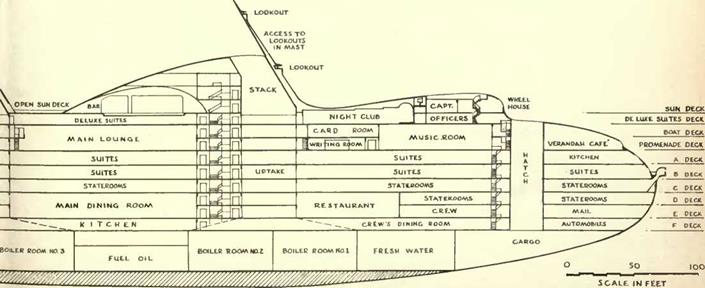і he development of mechanical transportation began a little more than one hundred years ago. To-day, speed is the cry of our era, and greater speed one of the goals of to-morrow.
Giving vent to the contemporary fear of terrific speed, the Quarterly Review, in 1825, exclaimed: "What can be more palpably absurd than the prospect held out of locomotives travelling twice as fast as stagecoaches? ” And stagecoach operators of Great Britain were elated when " experts ” declared that the railroad would be useless for human transport because man could not endure speeds of from twenty to thirty miles an hour to which speed maniacs proposed to subject them!
With developments in the realm of speed during the intervening century, we are all more or less familiar. With every advance, sceptics have not been wanting. Scepticism greeted the spluttering, stuttering, one-lunged buggy – automobile in the early days of Ford. It was the prelude to the performance of the Wrights at Kitty Hawk.” And always, speculators who have sold short developments in the realm of speed have found themselves worse confounded.
Year after year, speed records have been broken. Ultimate limitations on speed have now been pushed so far beyond the horizon that sceptics are silent. Optimism rules. One hears the easy, offhand prediction that the motor car will attain five hundred and the airplane a thousand miles an hour, as though this were a matter of course!
Speed, we say, is the direct result of power. Hence the uninformed optimist may conclude that we have only to put greater engines in the car or in the airplane in order to attain greater speed. But the problem is far more complex and varied, requiring the combined efforts of the engineer, the chemist, the designer; and one of them, at least, must possess great imagination. Exactly what I mean by this will appear if we consider some possible trends in the future design of motor cars, airplanes, locomotives and steamships.
Within the speed range of the automobile or the railroad train, an increase in speed of the vehicle produces an increased air resistance proportional to the square of the speed; also, the power required to increase the speed must be increased as its cube. Where such large amounts of power are required to produce relatively small increases in speed, it becomes imperative that all factors tending to produce resistance be minimized. Conversely the elimination of resistance-creating factors permits the same power plant to produce greater speeds, or to operate more efficiently at lower speeds. The present-day motor car of conventional design offers about five times the resistance of a perfectly streamlined vehicle. We realize at once that the efficiency of the design is a factor definitely controlling the higher speeds we anticipate for to-morrow.
Captain Sir Malcolm Campbell established a record of 245.733 miles per hour at Daytona Beach — over two miles a minute faster than the average airplane flies, but two miles a minute slower than the fastest airplane had flown till then. On the basis of computations by Helmholtz, this is twice as fast as the time required for man to coordinate brain and hand. At such
speed, objects seen in passing do not enter the consciousness until the driver is many yards past them. Obviously, we must assume that there is a definite limit to the speed at which the human hand can guide a car. Experiment alone can tell. At the moment we may assume that this limit lies somewhere in the neighborhood of three hundred miles an hour.
To-morrow, engineering science (and all the sciences allied with it for the production of requisite materials) will undoubtedly be equal to solving the enormous problems involved in producing a car equal to a speed of three hundred miles an hour. The problems are formidable, but not insuperable. They involve the power plant, refinements in structure and design, and other equally important considerations concerning thermo-efficiency, the resistance of fabrics to centrifugal force, and the strength of materials.
In the development of transportation and speed we have reached that point where design is increasingly important from the viewpoint of efficiency and safety. The nature of some of these design problems is brought out in high relief in the light of certain features of the Blue Bird in which Campbell established his record.11 Many things which affect an ordinary automobile only incidentally affect tremendously a high speed car such as the Blue Bird. When making four miles a minute, it has to combat a relative wind speed of two hundred and forty miles an hour. While enormous pressure is thus exerted upon the front of the car, the back of the car is ordinarily in a partial vacuum. The result is what engineers describe as negative pressure. If the condition is sufficiently marked, the car tends to turn turtle.
Distribution of the relative wind pressure as evenly as possible fore and aft
![]() DESIGNED BY MALCOLM CAMPBELL 193 і
DESIGNED BY MALCOLM CAMPBELL 193 і
must be accomplished by the most careful streamlining. The wheels themselves are streamlined. The effect streamlining has upon any object moving through a fluid, such as air or water, is tremendous.” Fairing is placed behind the front wheels to reduce the eddies and keep the air as free as possible from turbulence. Since the air which meets the rear wheels is turbulent to a degree, the fairing is placed at both front and rear.
I
Designing the wheels for a machine capable of such speed is in itself a tremendous problem. When a solid steel flywheel revolves beyond what is known as its critical speed, it flies to pieces, owing to the centrifugal force. When the Blue Bird attained a speed of two hundred and forty-five miles an hour, its wheels made in the neighborhood of twenty-three hundred revolutions a minute. At this speed the ordinary tire tread would be thrown off in tatters. In consequence, the tires were treadless. We are able to comprehend the effect of the centrifugal force from the fact that, when at rest, the wheels of the Blue Bird have a radius of seventeen and a half inches. At one hundred and fifty miles per hour, the radius increases to nineteen inches.
The Blue Bird is equipped with a supercharged airplane engine, a fourteen hundred horse-power Napier. Direct transmission from engine to the rear axle was impossible for the reason that this would have pushed the driver up to such a height that his presence would have interfered with the streamlining. By an indirect drive, the transmission shaft being offset to the left of center, this difficulty was overcome. The driver’s head is only thirty-nine and a half inches above the ground.
One of the interesting features in the design of this particular machine is the large vertical fin at the rear of the car. Its function is to serve as a stabilizer, without which it would have been impossible to keep the car moving in a straight line. At high racing speeds the slightest swerve is accompanied by possibly critical consequences. A change of direction on the part of a car
19 – LOCKHEED SIRIUS PLANE DESIGNED BY JOHN K. NORTHROP, RICHARD VON HAKE,
ALLAN LOCGHEAD. GERALD VULTEE 1929
speeding at two hundred and forty-five miles an hour causes the air pressure to be increased on one side and decreased on the other. The presence of the fin tends to keep the car in its original line of motion.
Numerous problems having to do with velocity remain to be solved, even when the car has once been effectively streamlined. Owing to inertia, water, fuel and air are pressed sharply against the rear of their containers. This inertia is sufficient to offset the force of gravity. While, ordinarily, the gas tank in the Blue Bird would have been a gravity tank, in view of its position, the effect of the inertia had to be overcome by a powerful automatic pressure pump in order to make certain a free and adequate flow of gas to the carburetors.
In a car going at two hundred and forty-five miles an hour the driver finds it impossible to put the brakes on suddenly. His strength is not adequate. If he had enough strength and did apply the brakes suddenly, the drums would instantly burn out, owing to the friction. Hence, in order to bring the machine to a stop, it is necessary first to let the momentum diminish. Then
the driver presses a pedal which connects with a vacuum motor. This motor puts the brakes on more evenly than the ablest driver.
The plane in which Lieutenant Stainforth, at Calshot, following the Schneider trophy contest, September, 1931, gained the world speed record of 415.2 miles an hour, was equipped with a Rolls-Royce 2 560 horse-power engine consuming over 2 gallons of fuel a minute. Compare this with the spluttering 16 horse-power motor of 1903. A roaring 2500 horse-power engine taxes the resources of the designer. The waste heat developed is enough to generate 1000 horse-power per minute. What shall be done with it?
Radiator pipes must be spread out so as not to spoil the streamline contour.
There is danger of premature firing because of the temperatures to which cylinder walls are heated. Where is the metallurgical chemist who will present us with new alloys that can withstand such intense heat?
It has been predicted that very soon we shall be traveling through the air at anywhere from seven hundred and fifty to a thousand miles an hour. Such predictions are the result of extreme and possibly unfounded optimism. With our limited knowledge of aeronautics, one may well hesitate to predict the ultimate speed of the air – 20 • zeppelin rail car
DESIGNED BY FRANZ KRUCKENBERG & CURT STEDEFELD 1929
plane.

 To-day, the average speed »
To-day, the average speed »
к
of express transport air – ] planes falls considerably below three hundred miles an hour. However, the day will come when for ordinary commercial purposes an airplane speed of three hun-
practicable. Some believe that this is the ultimate speed of airplanes for ordinary commercial purposes. We are justified in foreseeing that for military purposes airplanes will attain five hundred miles an hour. Flights at such speeds will presumably always have certain elements of risk.
When engineers, not to-morrow, but at some time in the not too remote future, succeed in building an airplane that can fly one thousand miles an

» CLIPPER SHIP COWPER DESIGNED BY JOSHUA MAGOUN 1854
hour, will the thousand-mile-an-hour plane be guided by a human pilot in the plane itself or by an automatic pilot and controlled from the ground by wireless? The question would be simpler to answer if we could be sure of gradually increasing the speed at a rate no greater than the acceleration of gravity; and if we could be sure of never stopping suddenly, and of never interrupting the momentum by a sharp turn or by a sudden, though slight rise or descent in
flight. When suddenly applying the brakes of your automobile while traveling at forty miles an hour, you may have been thrown forward over the wheel. When starting suddenly, you have been jerked backward against the seat cushions. Magnify that experience hundreds of times and you find it not difficult to imagine the result that would follow from a sharp break in the momentum of the plane traveling at a thousand miles an hour.
Of one thing I am positive. The airship of the future, regardless of its kind, will be as fool-proof as an automobile. I have no idea as to how it will be achieved, but I am positive that it will be. Many more remarkable things than this have been accomplished. With our flying at the present moment, we are in the position of a boy who, having jumped off the end of a dock without knowing the principles of swimming, is barely able to keep himself afloat. He kicks and splashes about and manages to stay on top. Nevertheless, he could not do it for long, nor in a choppy sea. On the other hand, once he has mastered a few simple principles, he finds that, after all, swimming is not so difficult.
A robot, built on the lines of the gyroscope, or on some principle yet to be discovered, may ultimately overcome for aviation the problem now present in the human factor. However, the extent to which it can be worked out to control the ship through various flying conditions, automatically offsetting unforeseen situations and complications such as running into other ships in the air, in landing and reacting properly to air-traffic regulations, is so far beyond the present status of aircraft development problems that it is mere speculation to comment upon the ultimate possibilities.
The future of the railroad is a problem regarding which engineering science is in a quandary. My own opinion is that further development as regards locomotives and trains will have to do with comfort, efficiency, and safety rather than with an appreciable increase in speed. For a long-distance locomotive run
the record is 102.3 miles per hour between Plymouth and London. That record has stood since 1904.
During the opening years of the present century, the competition between the railroads engendered a battle for speed. When the New York Central announced an eighteen-hour train from New York to Chicago, the Pennsylvania Railroad, though it had to climb the Alleghenies, as against the level route of the New York Central, retaliated by the announcement of another eighteen – hour train. When the Central cut the time to seventeen hours, the Pennsylvania did likewise. Thereupon, the Central put into effect a schedule requiring its express to cover the distance of nine hundred and ninety-one miles in sixteen hours — an average speed, including stops, of sixty-two miles an hour. Thundering around a curve at a little too much speed, a train sheared off the rail spikes and went over an embankment, though without loss of life. This was the end of the competition for speed. Until recently, the New York Central and the Pennsylvania have held to a twenty-hour schedule for their best trains. Twelve hours between New York and Chicago by train is not impossible but neither is it justified economically in the light of present-day progress in aviation, where even greater speeds are practical at considerably less cost.
Engineers could unquestionably design a locomotive equal to a speed greater than that at which any locomotive has ever been driven. Perhaps they would use steam; perhaps not. The really vital problems have to do with other
|
|
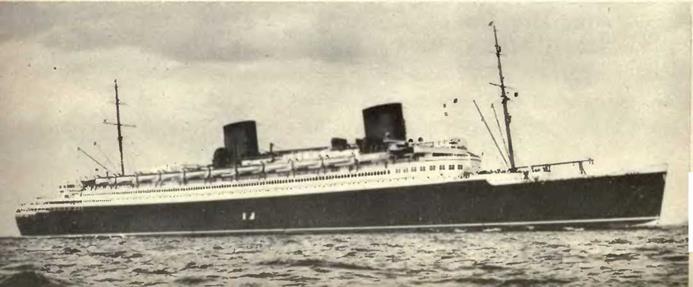
factors, such as the design of the rolling equipment and the maintenance of the roadbed. Certainly, in view of changing conditions, we may expect the railroads eventually to attain far better sustained speeds than are now possible. European experiments with regard to high-speed automotive units, designed for steel rails, point that way. A hundred miles an hour is not an impossible goal under certain conditions where traffic warrants it. Railroad men predict that, twenty years hence, short-unit trains of the automotive type, capable of a hundred miles an hour, may be dispatched every ten or fifteen minutes from New York to Boston, to Buffalo, and to Washington.

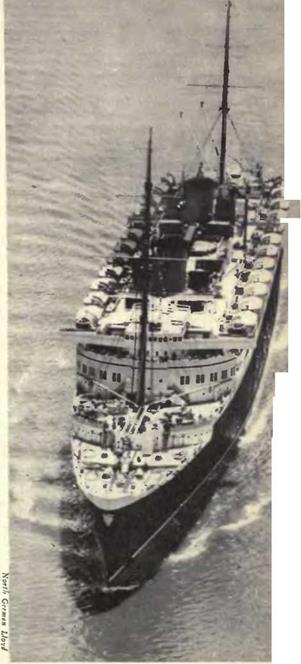 In Germany, there is now in use a propeller – drive car running on a stretch of ordinary railroad track.20 It has reached a speed of 113 miles per hour, and the indications are that a much greater velocity can be attained over long distances. This new "zeppelin on rails” resembles a low streamlined railway coach. The frame is slung between the axles in order to keep the center of gravity as low as possible The material used is steel tubing, aluminum and glass. It weighs 18 tons. The pusher – type four-bladed propeller is located at the extreme rear of the car and is driven by a 500 horse-power motor. It is maintaining a regular schedule of over 100 miles per hour and has, ever since it was built.
In Germany, there is now in use a propeller – drive car running on a stretch of ordinary railroad track.20 It has reached a speed of 113 miles per hour, and the indications are that a much greater velocity can be attained over long distances. This new "zeppelin on rails” resembles a low streamlined railway coach. The frame is slung between the axles in order to keep the center of gravity as low as possible The material used is steel tubing, aluminum and glass. It weighs 18 tons. The pusher – type four-bladed propeller is located at the extreme rear of the car and is driven by a 500 horse-power motor. It is maintaining a regular schedule of over 100 miles per hour and has, ever since it was built.
It is the fastest car on rails that has ever been built, and it has lived up to its specifications. I don’t predict that it will come into general use on American roads. It is an experimental project that worked out successfully and indicates a tendency in future railway design. The fact that it is streamlined, of light construction, with a low center of gravity, has more to do with its speed than its airplane motor propeller. It would be relatively simple to apply the same principle to an entire train as well as to one car.
We can foresee the time when motor boats will be approaching a speed of one hundred and fifty miles or more an hour. This is not at all improbable, though the goal will not be achieved soon. With the motor boat, unquestionably, will rest the record for speed on water. Neither the liner nor cruiser can be considered as its rival. Even if the difficulties in the way of forcing the giant liner up to a speed of one hundred miles per hour should prove physically possible of solution, the problem is nevertheless commercially insuperable. The fastest liners such as the Bremen and Europa have not yet exceeded the thirty-knot mark except for short distances, though warships have attained faster speeds.
As an example of organic design and its influence on the visual form let us consider the ship. From time immemorial up to the present moment the ship has always been one of the most fascinating of objects and to a great many people one of the most beautiful. It has probably aroused as much satisfaction as any work of man. This applies to nearly all types of sliips. But in particular I am thinking of such famous styles as the clipper ship,21 the four-masted schooner and the steam liner.” It would be easy to include such picturesque types as the sampan. The clipper ships were the liners of their day and the fastest commercial sailing ships ever built. The fastest crossing on record between America and Europe was twelve days and six hours.
What we’ve always liked about ships is that they have been first, last and
|
always ships. The ship has had the same logical development at the hands of men of the sea as the airplane has had at the hands of men of the air. For years, when aboard ship, if you are observing, you have seen better modern architecture (in 1932 terms) than you have ashore.24 But the ship has recently suffered a reactionary change that is disturbing. Commercial minds, reasoning that many people when traveling aboard ship like to forget they are at sea, have built all over the interior of the ship a lot of decorations in imitation of baronial halls and the like. They have endeavored to make ships into floating hotels. This is as illogical as painting stripes on a horse and calling it a zebra.
The quality that has for generations stood out and made us love ships is the style and character that has been a natural development, without affectation.
Now, shall we take this quality away from ships?
24 • S. S. CONTE BIANCAMANO DESIGNED BY ANSOLDO SHIPBUILDING CO. 1924

As an extreme illustration of the tendency just mentioned, I have in mind one of the largest liners, the Belgenland, which recently did over its decks to make them look like streets and alleys in a quaint little continental town!
The newer ships of the French and German lines are nearly as bad in a different way. They have merely used a different mode of interior decoration. Instead of being in the style of twenty years ago, they are in the so-called style of to-day, which is, in its general application, worse. A definite activity on the part of artists in all fields towards designing on the basis of functional requirements and the elimination of unessentials is the heart of the modern movement. For every artist in any field there are a hundred others who, not satisfied at being good craftsmen, make broader claims for themselves. These are the workers who depend on ornament to solve any problem. At the present moment Europe and America are deluged with this slang version of modern design. Actually it is the direct opposite of modern design. It has most of the faults of that great period of atrocities, the Victorian era, and in addition is vulgar and totally lacking in charm. Do not misunderstand my point. I am not urging that a modern liner be treated as one would a schooner; that portholes should replace windows, for instance. Nothing of the sort. A modern liner should be built along the most advanced lines. Twenty-five years ago portholes were the solution. To-day they are unnecessary. A whole deck may be glassed in as occasion demands. There is actually no difference between a porthole and a small window, except that a porthole is round and a window is
![]() DESIGNED BY NORMAN BEL GEDDES 1932
DESIGNED BY NORMAN BEL GEDDES 1932
rectangular. What I do object to is the application of land-architecture instead of continuing the development of ship-architecture in its own organic terms.

![]()
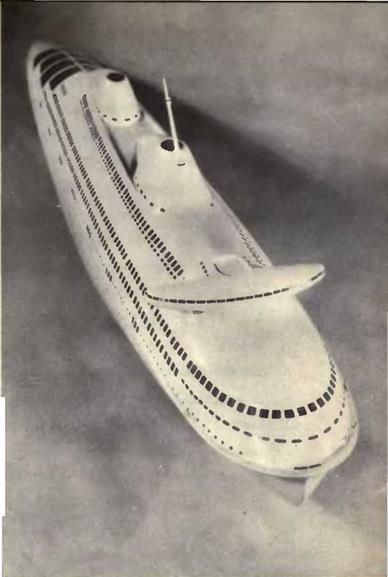 Now let us consider some of the problems involved in correctly designing the steamship for the needs of to-day. By comparison with a 5 00- mile-an-hour airplane, the ocean liner is a slow-moving mode of transport.
Now let us consider some of the problems involved in correctly designing the steamship for the needs of to-day. By comparison with a 5 00- mile-an-hour airplane, the ocean liner is a slow-moving mode of transport.
But speed is a relative thing. One cannot discuss the speed of a racehorse
■
with that of a bullet. Nevertheless, the world still recognizes that Man o’ War was undeniably fast!
The Bremen,22 although she broke |
"5 U
the speed record held by the Maure – s
w
M
tania for some 15 years, exceeded the * speed of the Mauretania by a very small margin. The Mauretania crossed from Ambrose to Plymouth, 3083 nautical miles in 4 days, 17 hours and 49 minutes, an average speed of 27.2 knots. The Bremen crossed from Ambrose to Cherbourg in 4 days, 14 hours, an average speed of 28.8 knots. Traveling a distance of 3175 nautical miles from Cherbourg Breakwater to Ambrose Lightship, the Europa beat the Bremen by only 9 minutes. The Europa is only 1.6 knots faster than the Mauretania. Thus, it is easily seen that in the Blue Ribbon speed contest on the Atlantic, small gains assume immense importance.
It is conceded that steamships will eventually make considerably better speed than now. But before they reach fifty knots, the practice now regarded more or less as axiomatic among marine engineers will have changed considerably. Some of the problems involved are obvious: a hull and a superstructure offering a minimum of resistance to water and air, and a greater ratio of motive power for each unit of weight. Every protruding form such as deck housings, ventilating funnels, stacks, lifeboats, no matter if as small as a cable, offers a wind-resisting surface and rear vacuum that in a form as large as a ship reaches an enormous total.”
Consistent with these principles, I have designed an ocean liner 1808 feet in length, with a molded depth of 120 feet, beam 110 feet, and approximately 70,000 tons displacement. Streamlined as to both hull and superstructure, it is designed for luxurious accommodations, economy of operation, and increased speed performance. It is a steamship that can be built and operated under existing conditions. Accommodations are provided for 2000 first-class passengers, and for a crew of 900 men. What I have sought for in this design has resulted in a radical departure from general practice.
The entire superstructure is streamlined.” Every air pocket of any kind whatsoever has been eliminated. All projections have either been eliminated or enclosed within the streamlined shell. The single protrusion is the navigator’s bridge and this is cantilevered and similar in shape to a monoplane wing, consequently offering a minimum of resistance to the air. The smoke-
stacks are a radical departure in appearance. They are oval on the inside, but on the outside, due to streamlining, they dissolve into the mass form of the ship almost со the point of disappearing.2’ The streamlined foil of the forward stack contains a cafe, with dance floor, orchestra and bar. The streamlined foil of the rear stack is a hangar and machine shop for two trimotored seaplanes.
Lifeboats are within the skin of the ship instead of being hung on an exposed deck.2* There are twenty-four of them, each accommodating one hundred and fifty persons. They are of the unsinkable type, completely enclosed, equipped with radio apparatus, and two weeks’ concentrated rations. The boat deck is isolated from passenger use except in case of emergency.” Its central portion is the upper space of the public social rooms. When the lifeboats are to be used, a section of the side of the boat deck hinges out to a position level with the deck and so forms a gangway.2* Two steel davits run out horizontally, carrying the lifeboat with them and lowering it to a position flush with the gangways. The gangways have railings on all sides with a gate in the center, so that passehgers can not fall off in the excitement. Passengers walk from the deck, across the gangway and directly into the boat. The
28 • OCEAN LINER: STERN DECKS OPENED DESIGNED BY NORMAN BEL GEDDES 1922
|
|
 I
I
30 • OCEAN LINER.- BOAT DECK
|
|
|
|
|
|
DESIGNED BY NORMAN BEL GEDDES 1932 |
same switch on the bridge that rings the alarm gongs over the ship simultaneously opens all hatchways to the boat deck, opens up the side of this deck and automatically puts each boat into position for loading.
Naturally, there is a relationship between the exterior contour of the ship and its internal arrangement. The skin of the ship is so designed that in rough weather, when the going is difficult and it would ordinarily require considerably increased engine power to offset a sixty-mile-an-hour wind, the entire form, including all deck area, is enclosed in a streamline form.27 At such times all air is mechanically conditioned. The movable elements of this outer skin are in the form of light alloy or glass panels that slide or coll up. Although on stormy days the ship is as enclosed as a submarine, on pleasant days she is more open than the present liner.2′ Among other open deck features she has an unobstructed play deck equal in area to four full-size tennis courts. The very large swimming pool, although under cover, is adjacent to the open air and a large sun-exposed sand beach.52
My aim has been to design a hull which offers least resistance to the water and a superstructure offering least resistance to the air. As regards the former, experiments have shown that the aim is accomplished by a hull design giving an even wave line and having the least wetted surface. In this connection, one of the latest developments is the Maier hull, which has consistently shown an increase of some ten to twelve per cent efficiency over the ordinary hull. Experiments with models and records of wind resistance of ships under actual operating conditions indicate that the speed of a ship like the Mauretania is reduced fifteen per cent in a sixty-mile gale. While the results of experiments in the streamlining of ship superstructures are very meager in quantity, data on other objects moving in air show that streamlining permits a reduction of air resistance of some eighty per cent.
Since a ship is essentially a slow-moving object, compared with an automo-
bile, and since the resistance varies with the square of the speed, this figure of eighty per cent is high except on the basis of extraordinary head winds. Such winds create high seas which increase the wave resistance. Future experiments will doubtless show that this circumstance offsets much of the saving due to streamlining the superstructure. In my opinion, the possible saving due to this feature in the present design is about fourteen per cent over the normal superstructure.
According to calculations, this liner should not only be more economical to build and operate than the fastest liner now in service, but she should, in addition, cut transatlantic steamship time by about one day. With a twenty per cent increase in speed, which appears to be a thoroughly reasonable estimate, the saving in time between New York and Plymouth would be twenty – two hours, an average speed of five and three-quarter knots greater than that of the Europa. This comparison becomes the greater in bad weather, for this ship is primarily designed to offset high winds and seas.

